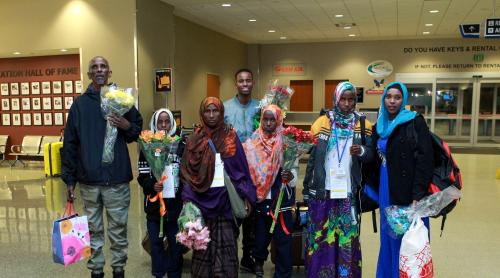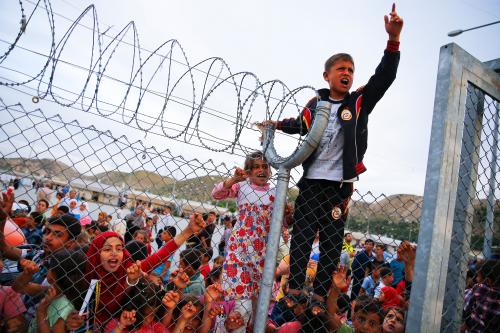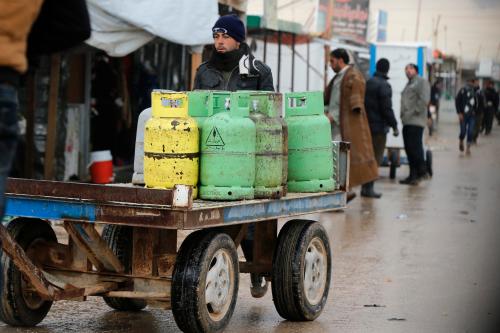Six years on, the Syrian civil war has decimated the country, displacing over half the population. Syrian refugees now number 6 million, growing from 100,000 in 2012, 1.5 million in 2013, and 4.8 million at the end of 2016. The numbers continue to grow, though at a slower pace as borders have largely closed. Turkey hosts 3 million refugees, with over a million in Lebanon. Jordan has 650,000 registered Syrian refugees, although possibly many more unregistered. There are also 900,000 asylum seekers in Europe and over 6 million internally displaced peoples.
With growing realization that imminent return is unlikely, refugees see their situation evolving as host countries adjust policies prodded by self-interest, local voices, and humanitarian and development support, often via Western funded concessional finance. The mindset of refugees has been explained through the five stages of grief, but these also seem applicable to host communities and their reactions. Neighboring countries are slowly moving beyond “denial” and “anger” to “bargaining”—internally on the politics of accommodating refugees, and externally with donors. While huge challenges remain, it is clear that refugees’ access to employment, education, health, and housing is slowly expanding. Equally clear is that securing livelihoods for the refugees and stability in the host countries is a global public good deserving of a global response.
On refugee rights, the seminal document is the 1951 Refugee Convention, and its 1967 protocol— adopted by 142 countries. These give access to courts, elementary education, provide identification and travel documents, assist in assimilation and naturalization, and ensure equal treatment with nationals in public relief, labor legislation, and social security. Refugees are accorded “favorable treatment… as regards wage earning employment.” Importantly, they are protected from “refoulement”—forcible repatriation.
Jordan and Lebanon do not adhere to the 1951 convention. Turkey does in amended form, providing refugee status only to those from Europe—targeting Turkish and Muslim minorities. Still, all three countries have proved surprisingly resilient to the large amounts of refugees, while a much smaller number of refugees have shaken a Europe already wary of immigrants.
Asylum seekers in Europe are in countries adhering to the 1951 convention. Yet, many Eastern European countries block refugees from entering, bolstered by strong public opposition. Many also oppose sharing hosting with Germany, Italy, and Greece. The European Union deal with Turkey has also been criticized for curtailing refugee rights. Germany, dealing with large numbers of asylum seekers, has adopted fast-track processing and limited protection, especially for family reunifications, while introducing expedited denials.
Lebanon’s Syrian refugees, 25 percent of the population, seen as threatening Lebanon’s confessional balance, are highly controversial and often unwelcome. The constitution’s preamble states that Lebanon abides by the United Nations charter, the Universal Declaration of Human Rights, and a 1962 law allowing political asylum for foreigners prohibiting refoulement. Mainly, a Lebanon-UNHCR memo determines refugee status. This provides temporary residence, ostensibly allowing the U.N. High Commissioner for Refugees to resettle refugees elsewhere. A $200 annual fee to maintain residence for refugees—key to accessing support—has been lifted. Refugee children enroll in Lebanese schools, with around 200,000 of 500,000 Syrian children currently registered already. Access to health care remains problematic, with UNHCR and NGOs working with a fragmented health system. Work permits for Syrian refugees are available in limited form in agriculture, construction, and domestic work.
Jordan’s constitution prohibits refoulement, relying on a UNHCR memo to regulate refugees as the agency works to place them in other countries. One-third of the 650,000 registered Syrian refugees in Jordan are children. In December 2016, 125,000 were registered in schools. Health care became a major challenge after 2014 when the government imposed fees to safeguard its health system; humanitarian agencies, nongovernmental organizations, the World Bank, and others also provide support. Over 200,000 Syrians work informally with many in construction and agriculture; however, nearly 60,000 now have work permits. With only 10 percent of refugees living in camps, housing remains a serious issue. Housing support is available, but, as of spring 2017, the government had received less than 5 percent of the $51 million requested.
In Turkey, a 1934 law regulated settlement of foreigners until the 2014 Law on Foreigners and International Protection provided temporary protection and access to courts and other services. School enrollment is open to refugees, but 40 percent of children (380,000) are not in school. Language aside, affordability is a barrier. A good portion of the 6 billion euros provided by the EU deal goes to education. Health care is free but language is a barrier. In January 2016, Turkey allowed work permits for the 600,000 Syrians working informally—formality means social security payments and minimum wages, making employers reluctant to apply. As of early 2017, the government had only issued 13,300 permits. Of Turkey’s 3 million Syrian refugees, 260,000 are in camps, the rest are often in sub-standard rentals. Public housing remains in discussion.
Progress is slow and uneven, but there is growing recognition that unrest, radicalization, and criminality are real dangers if livelihoods are not improved. It may be years before conditions allow repatriation. Given these realities and the need to prevent further destabilization and displacements, neighboring countries, Europe, and others must focus on social cohesion and access to livelihoods—which will also facilitate repatriation or refugees moving to third countries. Failure to create viable conditions for refugees will further fuel fragility in the region, as well as nativism and dysfunctionality in Europe and beyond.






Commentary
Syrian refugees and the slow march to “acceptance”
September 7, 2017